This page provides general information about cicadas. If you’re looking for information about this year’s emergence of 17-year periodical cicadas in Wisconsin, visit the Wisconsin Periodical Cicada website (cicadas.wisc.edu).
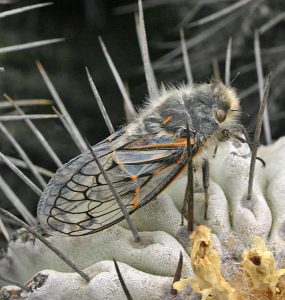
The cicadas are a group of insects in the order Hemiptera (true bugs) closely related to the much smaller aphids and leafhoppers with more than 1,300 species worldwide and the majority in the tropics. The dog-day cicada (Neotibicen canicularis), also colloquially known as the dogday harvestfly or heatbug in some places, is the most common species in Wisconsin, although there are at least nine species that occur here.

All cicadas have a similar shape, with stout, wedge-shaped bodies and a wide head with prominent, wide-set eyes on either side of a bulging nose-like structure (the post-clypeus), short antennae, and clear wings with noticeable veins that are held over their bodies like a roof. Dog-day cicadas are about 1½ inches long with greenish bodies with black markings.
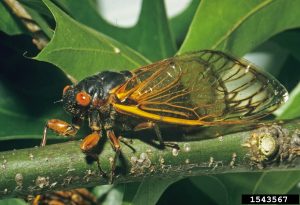
Periodical cicadas (Magicicada spp.) are black with reddish-orange eyes, legs, and wing veins. They cannot jump and do not walk or run well, so fly when they need to move more than a few inches. Cicadas are commonly eaten by birds, as well as bats, cicada-hunter wasps, ground beetles, dragonflies, spiders and robber flies, as well as other animals when there are mass emergences (and are consumed by humans in China and less commonly in other parts of the world).
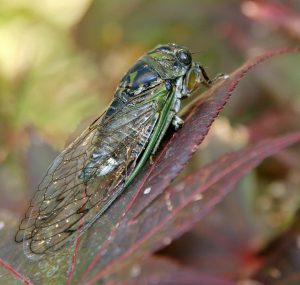
Most people wouldn’t notice the well-camouflaged cicadas at all if it wasn’t for the noise they make. Their persistent hum is the soundtrack of summer afternoons in the Midwest as the males “sing” to attract mates. The buzzing sound is created by rapidly flexing thin drum-like membranes (tymbals) on the underside of the abdomen at a high speed and amplifying the sound in enlarged chambers derived from the tracheae. The noise can be deafening when lots of males are calling all at once. Some cicadas produce sounds over 100 decibels! The repertoire of mating songs and other acoustic signals is unique to each species. That of the dog-day cicada is often described as a loud, high-pitched whine similar to a power saw cutting wood lasting for several seconds before fading away. Females lack the tymbals so do not make the buzzing noise but both can also make a different sound by flicking their wings.
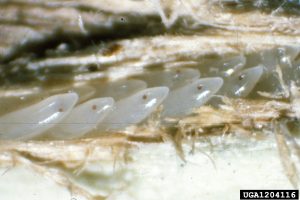
Females lay small clusters of elongate eggs in slits cut with her a large, saw-edged ovipositor into twigs and small branches, favoring the tender twigs of one-year-old growth. The eggs hatch in 6-10 weeks and the young nymphs drop to the ground to burrow to reach the tree roots. The strong first pair of legs of the nymphs are modified for digging and excavating chambers near roots where they feed on xylem sap. There they feed underground on xylem from the roots for two or more years, only moving from their original feeding site if adverse conditions arise. In the last nymphal instar, each nymph constructs its own exit tunnel to the surface. The so-called annual cicadas take 2-9 years, while the periodical cicadas take 13 or 17 years. The dog-day cicada normally completes its development in two years. Once the nymphs have completed their development they emerge from the soil at night and crawl several feet up onto tree trunks or other vertical surfaces. There they split their exoskeleton lengthwise down the back and the adult cicada crawls out, hanging downward as its wings expand and harden, leaving the characteristic hump-backed shell (exuvium) behind attached to the tree. The adults are active for a few weeks in late summer, spending their time mating and laying eggs without feeding much if at all on plant sap.

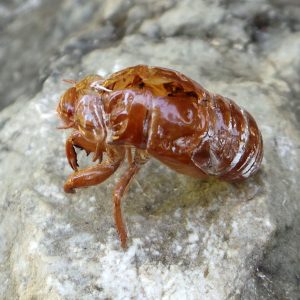
Annual cicadas appear from mid- to late summer (usually June through August) with broods that are not synchronized so some appear every year. The periodical cicadas emerge relatively synchronized over a few nights in large numbers at specific locations once every 17 years in the northern part of their range and once every 13 years in the southern part. Almost every year different groups (called broods) emerge somewhere in the eastern United States in late spring or early summer. Brood XIII, the predominant one in the southern Wisconsin counties of Crawford, Dane, Grant, Green, Iowa, Jefferson, Lafayette, Milwaukee, Richland, Rock, Sauk, Walworth, and Waukesha, isn’t due to show up again until 2024. (Brood VI, a less abundant population that was supposed to emerge in 2017, historically has been seen in central Wisconsin but wasn’t noted this time.)
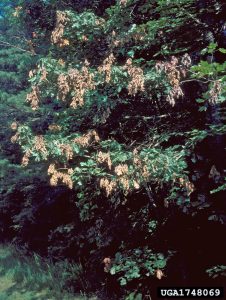
Cicadas feed on the roots of many woody plants. Oaks are commonly attacked but some other preferred trees include apple, ash, dogwood, hawthorn, hickory, maple, mountainash, and willow. Some other of the more than 80 reported hosts they may be found on in Wisconsin include arborvitae, blueberry, grape, raspberry, rhododendron, spirea and viburnum. In addition to the root feeding (which is generally inconsequential unless populations are very high on young or small plants) damage is caused when the female cicadas lay their eggs. The oviposition slits often cause the twigs to split, wither, and die, causing “flagging” of the affected stems.
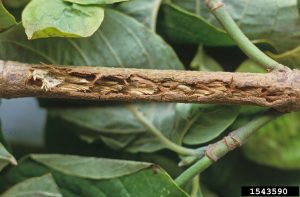
Oviposition scars appear as roughened punctures on twigs of many woody plant species. This is generally only a concern on young trees that have mainly branches that are of a size (¼ to ½ inch diameter) preferred by cicadas; established trees can tolerate a fair amount of flagging and is often considered a form of natural pruning. Injury to young trees or shrubs may result in the death, or more often, the disfigurement and loss of form due to attack of the tender leader shoots. Epinasty, an unnatural curvature of the new growth resulting from more rapid growth on the uninjured side of the branch, and breakage of the current season’s growth are the most common symptoms.
Annual cicadas rarely need to be controlled since they don’t occur in huge numbers simultaneously. Twigs severely damaged by periodical cicadas should be removed and destroyed to prevent the eggs from hatching to produce another generation of cicadas. Delayed pruning of ornamentals from the fall prior to a predicted periodical cicada emergence until after damage has been done can reduce the amount of plant material removed.
– Susan Mahr, University of Wisconsin – Madison





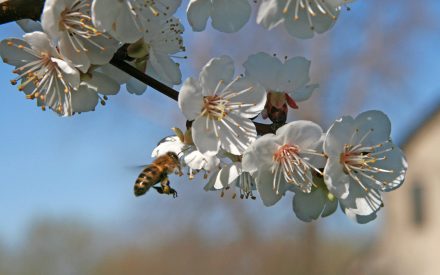 What’s All the Buzz? Woody Plants for Bees, Butterflies, and Other Bee-t-full Pollinators
What’s All the Buzz? Woody Plants for Bees, Butterflies, and Other Bee-t-full Pollinators ▶︎ Watch: Hydrangeas: Know Them and Grow Them
▶︎ Watch: Hydrangeas: Know Them and Grow Them Promoting Urban Forestry: Planting Bareroot Trees in Home Landscapes
Promoting Urban Forestry: Planting Bareroot Trees in Home Landscapes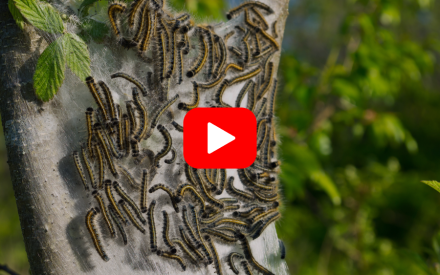 ▶︎ Watch: Torching Tent Caterpillars
▶︎ Watch: Torching Tent Caterpillars


